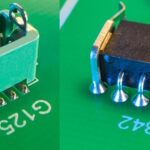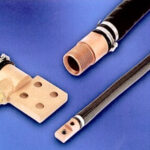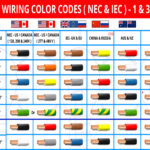Various locking mechanisms are found on connectors including bayonet, latch, lever, push-pull, screw, and snap-in. These represent the more common styles, not an exhaustive list. Locking connectors can support several functions like assisting coupling and uncoupling and improving the environmental ruggedness of the connection in addition to enhancing mechanical performance and preventing accidental uncoupling.
This FAQ reviews the basics of connector locking mechanisms and related applications.
A bayonet lock has a plug or pin on one half of the connector and a receptacle or hole on the other half. They are operated by aligning the two halves, pushing them together, and rotating the collar until an audible click is heard. They can usually be coupled or decoupled with a 1/3 turn. Bayonet locks are found on circular connectors for power, signal or RF contacts and are resistant to shock and vibration.
Latch locking
Latch locking uses a spring compression mechanism to prevent the two halves of the connector from separating or moving relative to each other. Depending on the design, the connectors need to be pulled, pressed, or rotated to release the two halves. Spring latches for circular connectors are usually made using steel springs to facilitate rapid coupling in the field and to support high mating cycles. Latch locking in rectangular connectors generally employs simpler plastic latches for low-cost applications that require a minimum number of mating cycles.
Lever locking
Some rectangular connectors use an external clamping mechanism instead of an internal one. These designs are more robust compared with simple latch locking. In a typical design, one half has a lever arm that fits into a grove on the other half (Figure 1). The level is moved to bring the two halves together, and the connection is often accompanied by an audible click. Lever locking is highly resistant to shock and vibration and is often used in applications like industrial equipment and transportation systems.

Push-pull locking
Push-pull locking is sometimes referred to as push-fit or push-and-press locking. Inner latches in the plug retract as the two halves are pressed together and they slot into matching groves inside the receptacle. When the halves are locked together, simple pulling can’t accidentally disconnect them (Figure 2). Disconnection requires that the connector body be squeezed while the connector halves are pulled apart. Some designs require the connector body to be rotated and squeezed for added safety. The simplicity of these designs supports small solutions. Push-pull locking is used where numerous quick connections and disconnections are expected and where accidental disconnection is highly undesirable like in medical systems. They are also found in soldier-worn equipment and battery terminal connections.

Screw locking
Screw locking uses threaded couplings to add improved environmental protection to the shock and vibration performance of bayonet locks. Different designs of screw locking are used on circular connectors compared with rectangular connectors. For circular connectors, the threads are on both halves of the connector. Some rectangular connectors use a central screw on one half of the connector with a corresponding receptacle on the other half. These connectors often use guide pins to align the two parts. Other types of rectangular connectors, like D-subminiature backshells, use jack screw mechanisms with a jack screw on both sides of the backshell and threads in the panel connector for inserting the jack screws.
Snap-in locking
Snap-in locks, also called snap-on or slide-on locks, are simple, low-cost, and compact. They simply snap together with a relatively small force and pull apart just as easily. That can be a strength and weakness, depending on the application. They are fast to connect, but the minimal retention strength can result in a higher risk of accidental disconnection compared with other locking styles like push-pull locking. Instead of being used in applications like healthcare, snap-in locking is suited for applications like electrical test equipment where quick and frequent coupling and uncoupling are needed and where compact designs are beneficial.
Summary
There’s a wide variety of connector locking mechanisms available. They provide varying degrees of secure connections, and some are more complex to implement than others. Different designs have been optimized for a range of application needs from communications connections to industrial, military, healthcare, and test and measurement systems.
References
Auto-Latching Medical Connectors, Amphenol
Connectors for Industrial and Commercial Transportation, TE Connectivity
Types of Locking Mechanisms, Souriau
What are the Different Types of Connector Locking Mechanisms?, Northern Connectors






Leave a Reply
You must be logged in to post a comment.